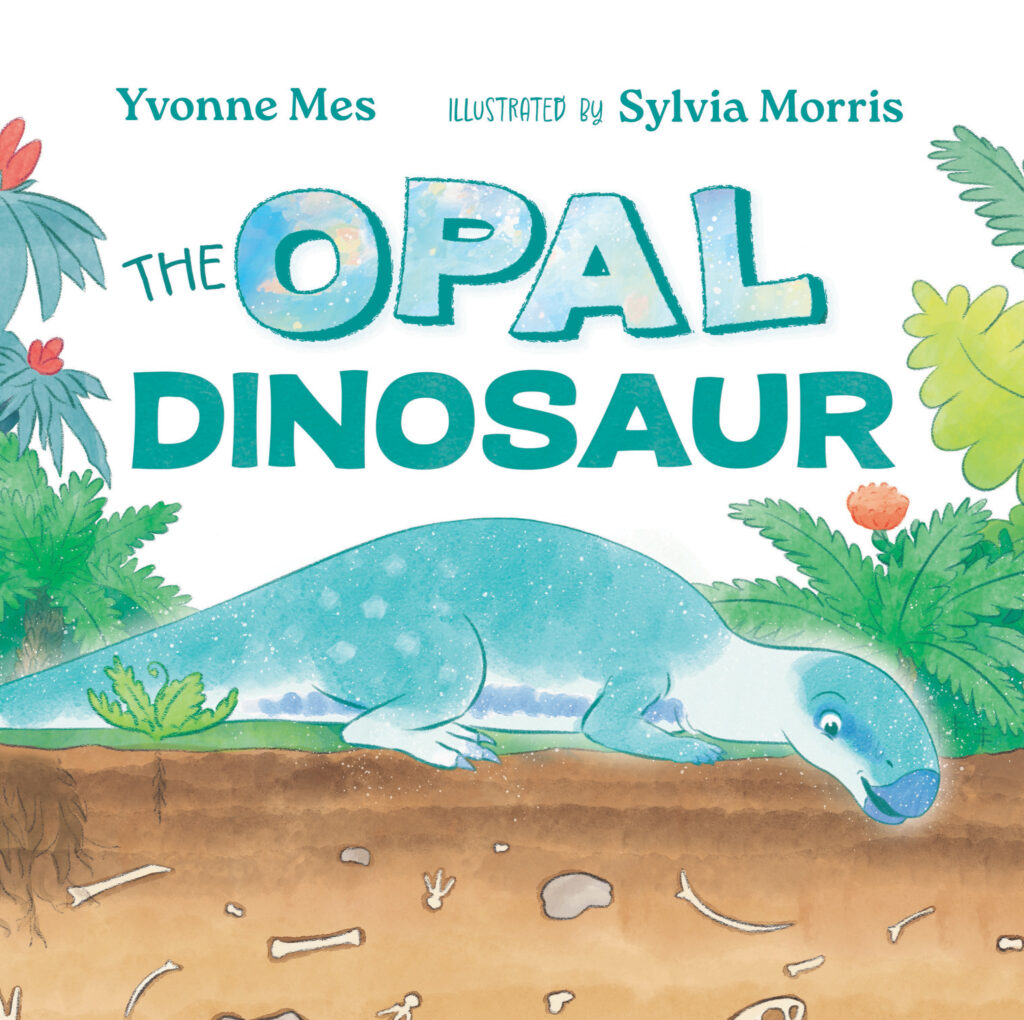The Opal Dinosaur
The true story of the discovery of a new Australian dinosaur with very special bones.
Millions of years ago, a small dinosaur slips and scrambles, before sinking into the earth. Her bones lie under the soil, slowly transforming into something wonderful. Then, one day, a miner spies a shimmer of blue and green.
The Opal Dinosaur explores the amazing discovery of rare opalised bones. Follow the journey as the bones are found, forgotten and then finally identified as an exciting new dinosaur species.
Written by Yvonne Mes, and published by CSIRO Publishing.
Release Date: August 2024

Highly recommended. This is an absorbing story that will appeal to many young readers.
Kathryn Beilby for ReadPlus (click for full review)
I am sure this attractively presented story, which so successfully blends imagination and information will become an instant favourite. It sets a standard that makes it a must for all home and school libraries.
Mia Macrossan for Story Links (click for full review)
More lovely reviews by Dimity Powell for Kids’ Book Review and Emily Ross for Good Reading. Plus a super in-depth video review/book club from Curiosity Mine:
Buy in Australia from…
…or find it locally through Your Bookstore.
Buy internationally from…
If you buy through the above link from Bookshop.org, I receive 10% directly, on top of regular royalties. On top of that, another 10% goes to participating independent US bookstores. Yay for Bookshop.org!
Behind the Scenes
What I was thinking…
Mostly I was thinking about how much I love dinosaurs and how cool it was that I was getting to illustrate a dinosaur book! An Australian dinosaur book! With opalised fossils! I read everything I could get my hands on about how to illustrate dinosaurs as scientifically as possible. I visited the museum to draw dinosaur fossils and I watched Prehistoric Planet to see how dinosaurs might have moved.
Story-wise, there were a few tricky things to solve. The main character dies partway through, and I was very unsure of how best to handle that. How to not make it too sad? How to hold onto a narrator who’s no longer alive? I spent a fair while pondering those questions.
Science-wise, I made a list of anything that might be unfamiliar, like the shape of Gondwana, and an MRI machine, so I would remember to draw them all into the book. Overall, I wanted to give lots of scaffolding to aid the imagination and help readers imagine both Australia’s prehistoric past, and modern dinosaur research.
How I made the pictures…
The illustrations were made in a program called Clip Studio Paint. I used one digital pencil for the lines, and then a handful of brushes designed to mimic watercolour for the colours. Each object was built up with multiple layers to get the colour and value that I wanted.
I also scanned in a few watercolour pages to get some nice rock textures for the underground scenes.
I used the scientific paper which formally describes Fostoria dhimbangunmal to help me accurately draw the fossils throughout the book. Fun fact: On the page with the white background, I drew the fossils at life-size!
For the illustration style, I aimed for simplified realism in both stylisation and colour. This was in order to support clarity, and direct attention towards the facts. I also used colour to support the emotional story in a few points, and to highlight the environmental differences between prehistoric and modern Australia.
Who else was involved…
The author is Yvonne Mes. Thanks for writing this story, Yvonne! I still can’t believe I was lucky enough to be the illustrator. It’s filled with heart, with facts, with intrigue, with history and with science! So many things for one story to do, and she fits it all together beautifully.
It’s published by CSIRO Publishing, where the whole team are absolutely lovely. In particular, Briana Melideo, the Kids Publisher, was fantastic to work with and made the whole process super enjoyable. And extra thanks to Melinda Chandler for believing me when I said I could draw dinosaurs, despite me having none to show her.
There are also the people who lived this story. Bob Foster, who found the fossils and chose to donate them to science, when he couldhave chosen to sell them instead. Phil Bell, who recognised the fossils for what they were and, in collaboration with others, dedicated the time and energy and ingenuity to figure everything out in more detail.
And a final thank you to Peter Schouten and James Kuether, who weren’t involved, per se, but I am very grateful for their work. The act of reconstructing an animal or environment, starting from the scientific paper describing its fossils, is its own profession: paleaoartist. The skills required take years to learn, and paleaoartists also have to stay up to date with all the new discoveries too. All of us who illustrate dinosaurs are standing on their shoulders: Thank you!
The scientific paper that describes Fostoria dhimbangunmal:
Learn more:
An ABC documentary about opalised fossils from Lightning Ridge, featuring Greg Foster and the Fostoria discovery, along with Dr Elizabeth Smith and Jenni Brammall from the Australian Opal Centre:
A video about the Opal Dinosaur discovery from Curiosity Mine, including interviews with Dr Phil Bell, and Dr Elizabeth Smith from the Australian Opal Centre.
A video about Lightning Claw and the science/tech of 3D printed bones, with Dr Phil Bell, from the University of New England.
News reports on the discovery of Fostoria dhimbangunmal, featuring photos of the fossils, from the ABC, National Geographic, and Smithsonian Magazine.
The website for the Australian Opal Centre, where the Opal Dinosaur’s fossils live, has all sorts of information about opals and opalised fossils.